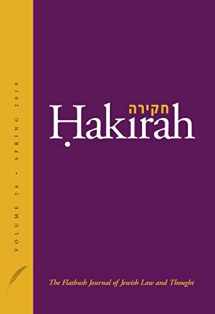
Hakirah: The Flatbush Journal of Jewish Law and Thought (Volume 26)
Book details
Summary
Description
In “A Categorization of Errors Encountered in the Study of Zemanim,” the author demonstrates that halachic decisions in determining issues such as zmanei tefillah and the beginning and end of Shabbos are sometimes inaccurate because they do not account for the astronomical realities related to season and location. In “A Halachah in Mishneh Torah,” we see how the restructuring of the halakhot in Mishneh Torah by printers over the ages has for centuries deprived students of Rambam’s nuanced, measured, and finely structured lessons. A Hebrew article regarding the myth of Bugonia discusses Torah issues related to the ancient belief in the spontaneous generation of the bee. Error in practice rather than psak is the subject of an essay entitled “Asking a Child to Do a Melachah on Shabbat,” which addresses a particular case of laxity in observance of settled law. According to the Torah, no one is infallible; even the greatest in Israel are subject to error. An article in our Tanakh section, “From the Monarchy of David to the Children of Israel: A Comparative Study of Family Values and Legacy,” seeks to identify the flaw that led to the decline of the monarchy of the family of David HaMelech only two generations after his death. An essay in our Jewish Thought section, “Attitudes toward the Study of Zohar and Lurianic Kabbalah, from the Dawn of Chasidism to Present Day Chabad,” explains the position of Lubavitch leaders regarding the study of Kabbalah. Their belief that Chabad ḥasidus represents the peak of the development of the wisdom of Kabbalah led some to discourage study of primary Kabbalistic sources because of the danger of misinterpretation. On the other hand, in the other essay in this section, “Evolutionary Ethics: The Ta‘amei Hamitzvot of Rav Kook,” we learn that Kabbalistic thought was central to the philosophy of Rav Kook and discover his daring position that the nearing redemption would produce new insight into the reasons behind mitzvot. In our Tanakh section, “Ibn Ezra’s Interpretation of the Garden of Eden: Reality, Allegory or a Combination of the Two?” examines the rationalistic approach of one of our greatest commentators in reading the early parts of Bereshit.A follow-up to the article on Rav Moshe Soloveitchik in the last issue of Ḥakirah dispels old misconceptions and adds further evidence of and insight into the refusal of Rav Ḥayyim Brisker and his son to align themselves with Agudath Israel. Another Hebrew article, on the development of the Olam Ha-Torah in America immediately after World War II, seeks to explain why a once homogenous American Orthodox community split apart.Articles dealing with Jewish law cover a wide range of issues, dealing with both the common and uncommon. “Hormonal Intervention for the Prevention of Chupat Niddah” provides important guidance on how to use medical knowledge effectively in the practice of halakhah. In our History of Halakhah section, “Conditional Marriage to Prevent Suffering: Rav Yehudah Amital’s Approach” describes the kiddushin al tnai used by an important Dati Leumi Rav to prevent situations of iggun. And “‘Till Death Do Us Part: The Halachic Prospects of Marriage for Conjoined (Siamese) Twins” reviews rabbinic writings on the phenomenon of con-joined twins and its implications in halakhah. In “Are Converts to Judaism Required to Immerse Their Utensils after Conversion?” the author details a wide range of opinions among aḥaronim, some touching even upon the mystical.Other articles deal with scholarly examination of Torah texts. In “Did ArtScroll Censor Rashi?” the author rebuts an accusation of censorship by showing evidence that an omission of controversial words was based on consideration of the most reliable sources. And in “Kaddish de-Sidra: Virtual Kaddish Embedded in Our Daily Prayers” the author shows three places in our daily prayers that contain a tripling of the Kaddish ideals.


We would LOVE it if you could help us and other readers by reviewing the book
Book review



